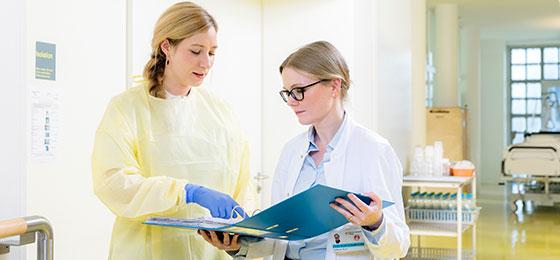Completed project: Sources and transmission pathways of resistant pathogens

Antibiotic-resistant enterobacteria are responsible for many infections. It is unclear whether they are mainly transmitted between people or whether other sources such as food play an important role. A large-scale analysis of samples from different sources across Basel has now revealed possible transmission routes.
Sarah Tschudin Sutter (r.) with staff member: Contact with patients infected with antibiotic-resistant germs requires special protective measures. But transmission is not only possible in hospitals and not only between people.
Increase in resistance beyond healthcare facilities
The most common bacterial pathogens include some types of enterobacteria such as Escherichia coli . Many of them are now resistant to antibiotics. In particular, the so-called ESBL-producing bacteria are problematic: they form enzymes that break down certain antibiotic agents and render them ineffective. Such pathogens initially spread mainly in hospitals. However, for some years now, they have become increasingly widespread outside healthcare institutions. Urinary tract infections are among the most common conditions that are caused by such bacteria.
The increase in ESBL-producing enterobacteria outside hospitals leads to the assumption that other sources of transmission, such as food, may be involved. However, it is difficult to trace the routes by which ESBL-related resistance is spreading. This is because extensive genetic comparisons are needed between samples taken promptly from infected individuals and from different possible sources. A further difficulty is that bacteria exchange individual mobile genetic elements among their type but also with other types of bacteria. As a result, resistance can spread between bacteria.
Possible sources investigated across Basel
Sarah Tschudin Sutter and her team have now collected and analysed numerous samples from various sources in the city of Basel. They systematically took samples from colonised and infected patients at the University Hospital Basel over a period of two years. During the same period, they examined monthly wastewater samples from the sewage system of every Basel neighbourhood. In addition, they examined poultry meat, herbs, sprouts and salads for ESBL-producing bacteria. They bought these samples once a month in a large supermarket and a small shop in each neighbourhood.
Using whole genome sequencing (WGS) to analyse all the samples, they were able to determine the genetic relationships between the ESBL-producing bacteria and find out more about the roles of humans, wastewater and food in spreading resistances.
Many antibiotic-resistant germs in wastewater
It became obvious that ESBL-producing enterobacteria are very widespread in the population: they were found in over 90% of all wastewater samples. By far the most common was Escherichia coli . Wastewater monitoring could therefore make a decisive contribution to the general monitoring of antibiotic resistance in the future, the researchers conclude.
Of the food samples, over 17% of poultry and 2% of vegetable samples contained ESBL-producing bacteria. Here, too, Escherichia coli was the most common type. However, Sarah Tschudin Sutter and her team also discovered other ESBL-producing antibiotic-resistant bacteria in wastewater and food samples, such as Klebsiella pneumoniae . These are an important cause of various infections, including urinary tract infections and pneumonia.
Transmission to humans occurs
The analysis of the genetic sequencing showed a large genetic diversity of bacterial strains, i.e. few relationships overall. This indicates that a variety of different sources must be involved in the spread of antibiotic resistance. The high proportion of wastewater samples with evidence of antibiotic-resistant bacteria indicates that they are widely distributed in the population. This backs the observation made in recent years that a large share of transmissions takes place outside hospitals. The data also showed that resistant bacteria are rarely transferred from food to humans, but that this does occur.
In a follow-up project, the researchers will now evaluate which mobile genetic elements occur in different unrelated bacterial strains. By doing this, they are clarifying the role that the exchange of these elements, known as horizontal gene transfer, plays in the spread of resistance between humans, food and wastewater.
